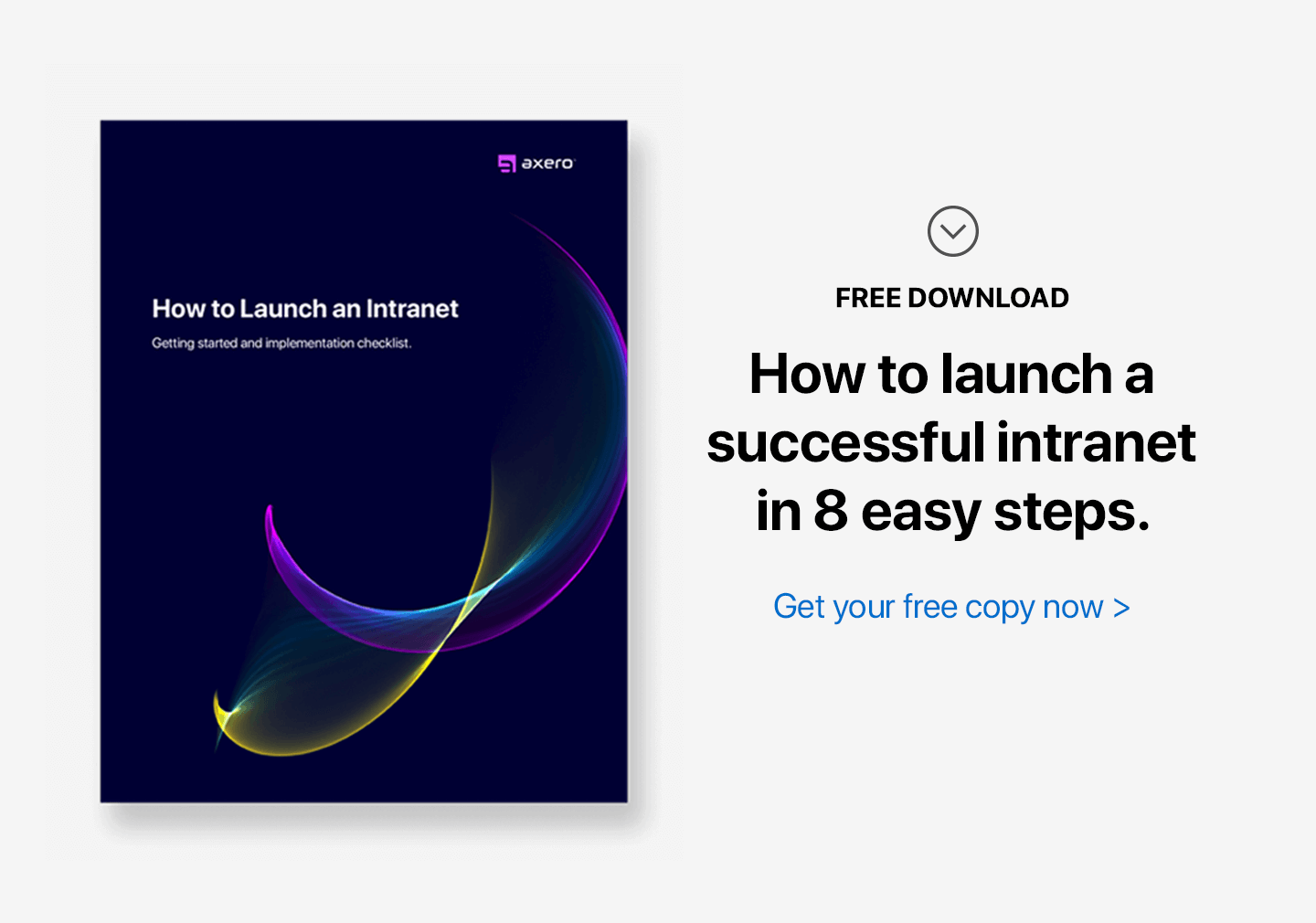Getting started.
— Manager
I picture this Manager sitting at her desk in front of a pile of shitwork with deadlines posted all over. She is probably feeling a lot of pressure and stress, but not enough to stop her from procrastinating.
So, how does she get started?
How do we get started?
This question takes me back to the origins of my company. It’s the biggest thing I’ve ever started. Where did I find the motivation? Vivek and I started Axero out of pure desperation. Vivek was so broke that he couldn’t afford to buy a plane ticket to fly back to India. I had a shorter trip home but couldn’t decide between starvation and going back to my parents’ basement.
So, Vivek and I put our brains together and came up with a company name. Next, we threw a website together and started looking for jobs on Craigslist. The entire project took us about an hour. It was the fastest company launch I’ve ever heard of.
Had we more time or money or loftier goals, Axero may not have ever lifted off the ground. We might have still been looking for the right moment, the right idea, the right partnership.
Luckily, we didn’t have to get it right. We were not afraid of failure because it had pretty much already happened. We had both of our butts and all four of our feet firmly planted on rock bottom. So, that’s where we started.
What can a normal, slightly unmotivated, and in no way desperate person learn from our rocky past? What did we learn from it?
I’ll borrow a line from the author/blogger Mark Manson, who calls it “The Subtle Art of Not Giving a F*ck.”
On the one hand, Vivek and I were desperate. On the other, we had no expectations. We had the freedom to take risks, change our minds in mid-flight, and make all the wrong calls we could. That freedom proved vital to our business.
If you have a title, a salary, and an office, you may not feel like you have a lot of freedom to try, to fail, or to not try at all. But you do. And you should remind yourself of that fact daily. The late Steve Jobs said he looked in the mirror every morning and asked himself:
“If today were the last day of my life, would I want to do what I am about to do today?”
It was his way of reminding himself that he had a choice.
Our Manager does not even need to ask the question. It’s clear she doesn’t want to do her work on the last day of her life—or any other day. If you are like her, then why not pretend for a moment that you will never do it again? Then watch for the feeling you get. If you feel relief, you know you’ve got to quit your job. If it’s panic, use it to motivate yourself.
Desperation no longer moves Vivek and me. We get things started and done because we know they are important. We don’t assume that whatever was important to us yesterday still matters today. We juggle the list.
To help ourselves make those decisions day in and day out, we set loose goals. Our goals are to (a) grow our business, and (b) have fun. If a project doesn’t serve either purpose, we won’t do it. Why procrastinate something if you can kill it?
I don’t want to pretend that these are clear-cut choices. They are not. And we took a long time to get good at making them. When we first started, Axero had no focus whatsoever. We would take any paid work we knew how to do (and some we had to figure out on the fly) and tinkered with our Axero software on the side.
When the first wave of desperation passed, we focused on Axero and made it Axero’s only product. But what was Axero? We had different answers depending on who was asking. We called it “social business,” “social networking,” “community building,” “collaboration,” “knowledge management,” “intranet,” and any other relevant-sounding buzzword.
With this kind of “focus,” it was hard to decide how to position ourselves in the marketplace and what types of features to develop. Axero had to be one thing, and it became an intranet. Then it needed to define itself further within the social intranet space. It claimed the middle ground, between the turnkey solutions and the customizable ones, where it proudly sits today.
Deciding what was important in our business was never a simple choice, but a complex iteration in which our goals determined our projects and our projects redefined our goals. Because we put so much thought into setting our priorities, we have a whole different level of commitment to the projects that pass our test. That’s not to say we love every single one, but we’ve learned to get the help we need so that we never have conversations like the one I had with my buddy “Bob” the other day:
BOB: I gotta get these videos edited so I can put them on YouTube.
TIM: You’ve been talking about it for months. Just take ten minutes and do it.
BOB: I can’t do it in ten minutes. I need to learn the software first.
TIM: Hire someone to edit them for you.
BOB: Yeah, you’re right… It’s a good idea. But…
I’m sure six months from now I’ll still hear about Bob’s videos. Bob knows his videos should go on YouTube where they can get views, likes, and shares. What he doesn’t know is what impact these videos will have on his success. Or, what success means to him at this moment. And since he doesn’t understand the impact, he doesn’t know how much time or money he is willing to spend on these videos. He does seem to be clear on one respectable point though: editing videos is not something he’d do on the last day of his life.
Perhaps it’s time our Manager clarified her priorities, rethought her commitments, and got a little help? Or maybe she’s already done it all. What if she is facing important work she cannot delegate, but her brain is still resisting it with all its might? In this case, her brain is probably wrong, but it doesn’t know it yet. The brain thinks the project is a long boring ordeal that will end in a humiliating failure. You can’t argue with your brain—you will lose every time. But you can trick it.
Here’s how to trick your brain into getting started. (Note: Do this only when you know you will get rewarded in the end. Otherwise, your brain will figure out it’s been tricked and close the loophole. Then you’re on your own with your procrastinating brain, and I would not want to be in your shoes.)
Remove all expectations. Tell yourself, you won’t get anything accomplished, and you won’t spend any time. Just open your computer. Put the document in front of you. Write a few words. Do one pushup. Just do something. With pressure lifted, your brain might enjoy the first step and realize it’s been wrong all along. It’s happened to me many times!
For example, I used to hate giving demos of our software. I felt like a cheap robot, going through the same motions every time. I took it personally when people who asked me to do the demo barely said a word during the whole production. I even made a video of myself giving the demo, so I wouldn’t have to do it live.
One day a company from India requested a demo. I had to wake up at the crack of dawn to talk to them real-time. I sent them the video and almost canceled the live demo, but sanity prevailed.
It turned out they did not need my canned demo. They had watched the video and had already signed up for a free trial and started building their site. They were excited about it. They showed me what they had done and asked for help with a few details. It was nothing like what I expected. I made a wonderful personal connection. Time flew. And I am sure they will sign up.
Procrastination is your brain’s way of sending you a message. Nine times out of ten, it’s a message worth listening to. It could say that your actions are not in line with your priorities. It could say you’re not ready. It could also be wrong, in which case you are dealing with a bad habit and need to give yourself space to overcome it.
Be patient. Get to the bottom of your resistance. This is the time to be slow, not fast. Remember, you will always have projects to start, but you won’t always be around to complete them. Know which ones matter to you.
_____
If you like to procrastinate, you might like my book, because it’s a great excuse to put off everything else.












 info@axerosolutions.com
info@axerosolutions.com 1-855-AXERO-55
1-855-AXERO-55


